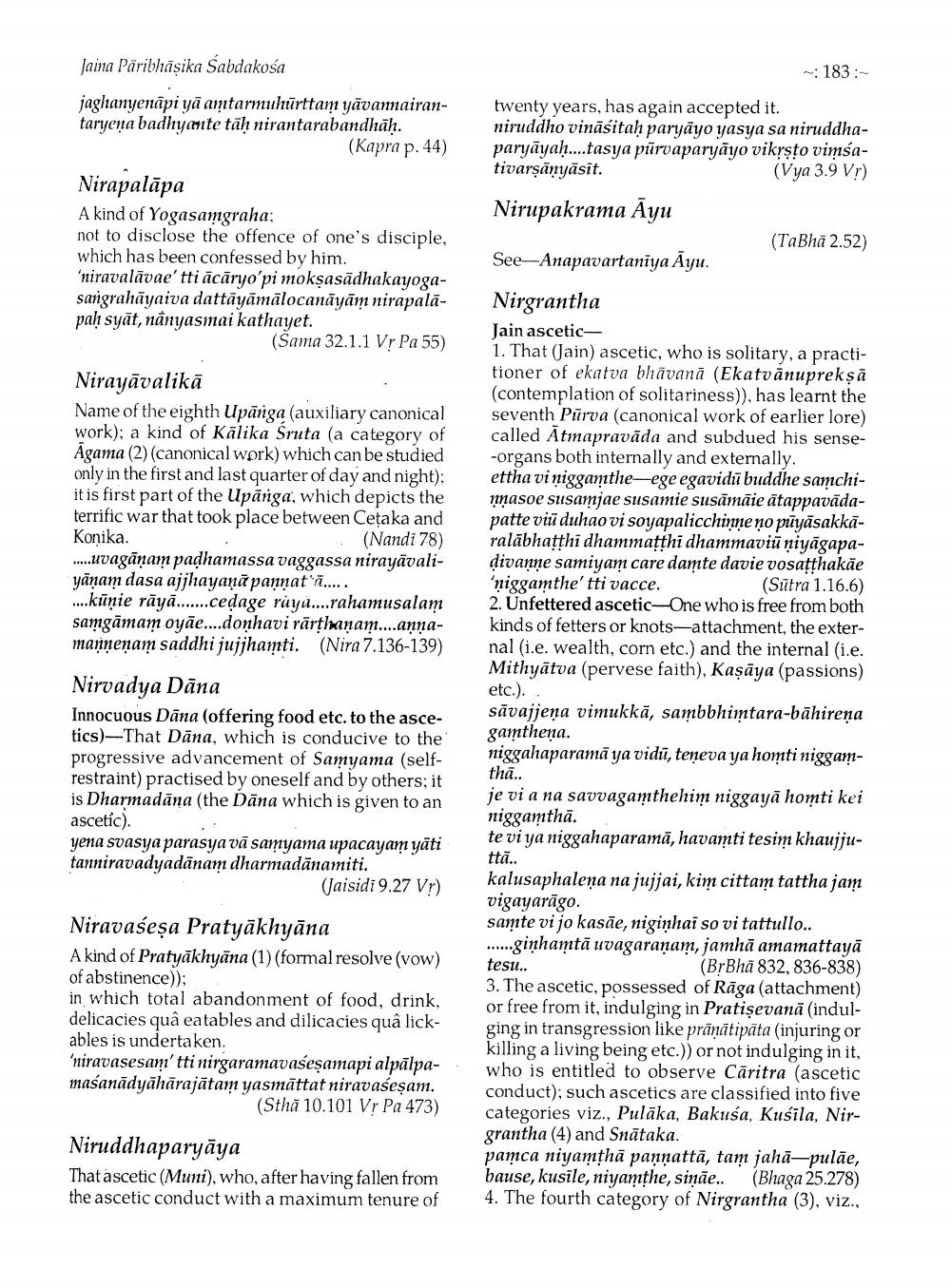________________
- 183:
Jaina Pāribhāșika Sabdakosa jaghanyenāpi yā amtarmuhūrttam yāvannairantaryena badhyamte tāh nirantarabandhāh.
(Kapra p. 44)
Nirapalāpa A kind of Yogasamgraha; not to disclose the offence of one's disciple, which has been confessed by him. 'niravalāvae' tti ācāryo'pi mokṣasādhakayogasarigrahāyaiva dattāyāmālocanāyām nirapalapah syāt, nânyasmai kathayet.
(Sama 32.1.1 Vr Pa 55)
twenty years, has again accepted it. niruddho vināsitah paryāyo yasya sa niruddhaparyāyaḥ....tasya pūrvaparyāyo vikysto vimsativarsányāsit.
(Vya 3.9 Vr) Nirupakrama Āyu
(TaBhā 2.52) See-Anapavartaniya Ayu.
Nirayāvalikā Name of the eighth Upānga (auxiliary canonical work); a kind of Kālika Sruta (a category of Agama (2) (canonical work) which can be studied only in the first and last quarter of day and night); it is first part of the Upānga, which depicts the terrific war that took place between Cetaka and Konika.
. (Nandi 78) .....uvagāņam padhamassa vaggassa nirayāvaliyānam dasa ajjhayaņā pannat ..... ....kūnie rāyā.....cedage ruyu....rahamusalam samgāmam oyāe....donhavi rärthanam....annamannenam saddhi jujjhamti. (Nira 7.136-139)
Nirgrantha Jain ascetic1. That (Jain) ascetic, who is solitary, a practitioner of ekatva bhāvanā (Ekatvānupreksā (contemplation of solitariness)), has learnt the seventh Pūrva (canonical work of earlier lore) called Atmapravāda and subdued his sense-organs both internally and externally. ettha vi niggamthe-ege egavidū buddhe samchiinasoe susamjae susamie susāmāie ātappavādapatte viü duhao vi soyapalicchinne no püyāsakkaralābhatthi dhammatthi dhammaviü niyāgapadivanne samiyam care damte davie vosatthakāe 'niggamthe' tti vacce. |
(Sutra 1.16.6) 2. Unfettered ascetic-One who is free from both kinds of fetters or knots-attachment, the external (i.e. wealth, corn etc.) and the internal (i.e. Mithyātva (pervese faith), Kaṣāya (passions) etc.). sāvajjeņa vimukkā, sambbhimtara-bāhireņa gamtheņa. niggahaparamā ya vidū, teneva ya homti niggam
thā..
Nirvadya Dāna Innocuous Dāna (offering food etc. to the ascetics)-That Dāna, which is conducive to the progressive advancement of Samyama (selfrestraint) practised by oneself and by others; it is Dharmadāna (the Dāna which is given to an ascetíc). yena svasya parasya vā samyama upacayam yāti tanniravadyadānam dharmadānamiti.
(Jaisidi 9.27 Vr)
etic).
tesu..
Niravašesa Pratyākhyāna A kind of Pratyākhyāna (1) (formal resolve (vow) of abstinence)); in which total abandonment of food, drink, delicacies quâ eatables and dilicacies quâ lickables is undertaken. 'niravasesam'tti nirgaramavasesamapi alpālpamašanādyāhārajātam yasmāttat niravaćeşam.
(Sthā 10.101 Vr Pa 473)
je vi a na savvagamthehim niggayā homti kei niggamthā. te vi ya niggahaparamā, havamti tesim khaujjuttā.. kalusaphalena na jujjai, kim cittam tattha jam vigayarāgo. samte vi jo kasāe, niginhai so vi tattullo.. ......ginhamtā uvagaranam, jamhā amamattayā
(BrBhā 832, 836-838) 3. The ascetic, possessed of Rāga (attachment) or free from it, indulging in Pratişevanā (indulging in transgression like prāņātipäta (injuring or killing a living being etc.)) or not indulging in it, who is entitled to observe Caritra (ascetic conduct); such ascetics are classified into five categories viz., Pulāka, Bakusa, Kusila, Nirgrantha (4) and Snātaka. pamca niyamthā paņņattā, tam jahā—pulāe, bause, kusile, niyamthe, siņāe.. (Bhaga 25.278) 4. The fourth category of Nirgrantha (3), viz.,
Niruddhaparyāya That ascetic (Muni), who, after having fallen from the ascetic conduct with a maximum tenure of




